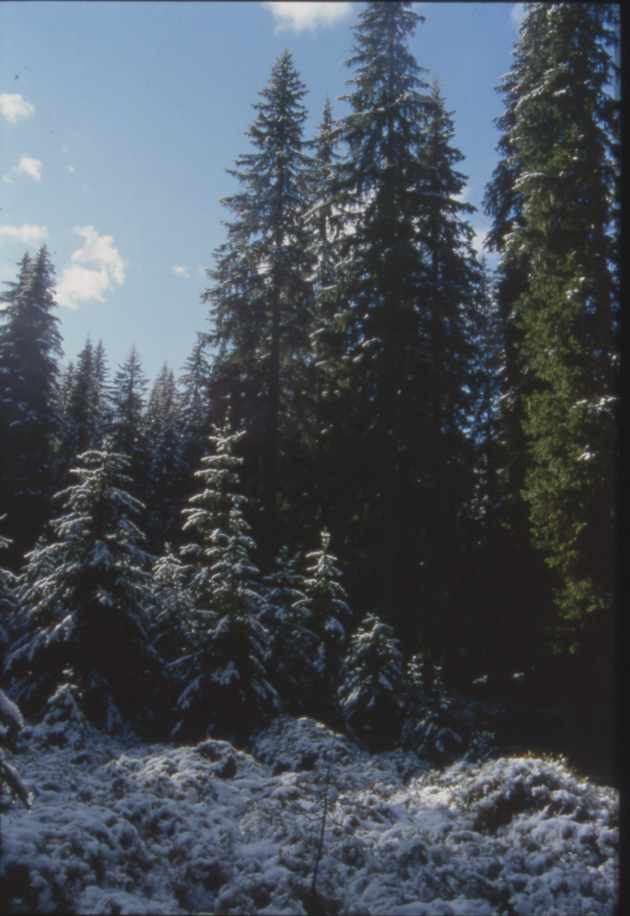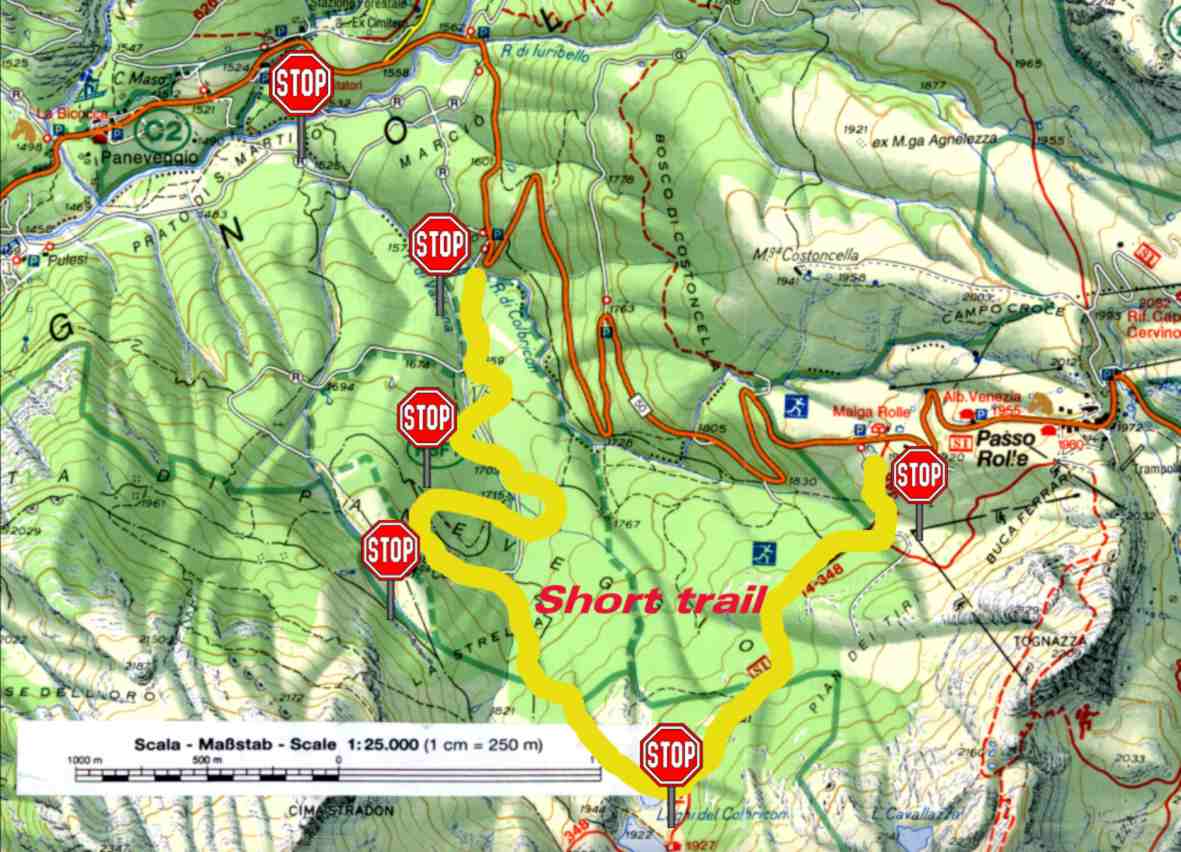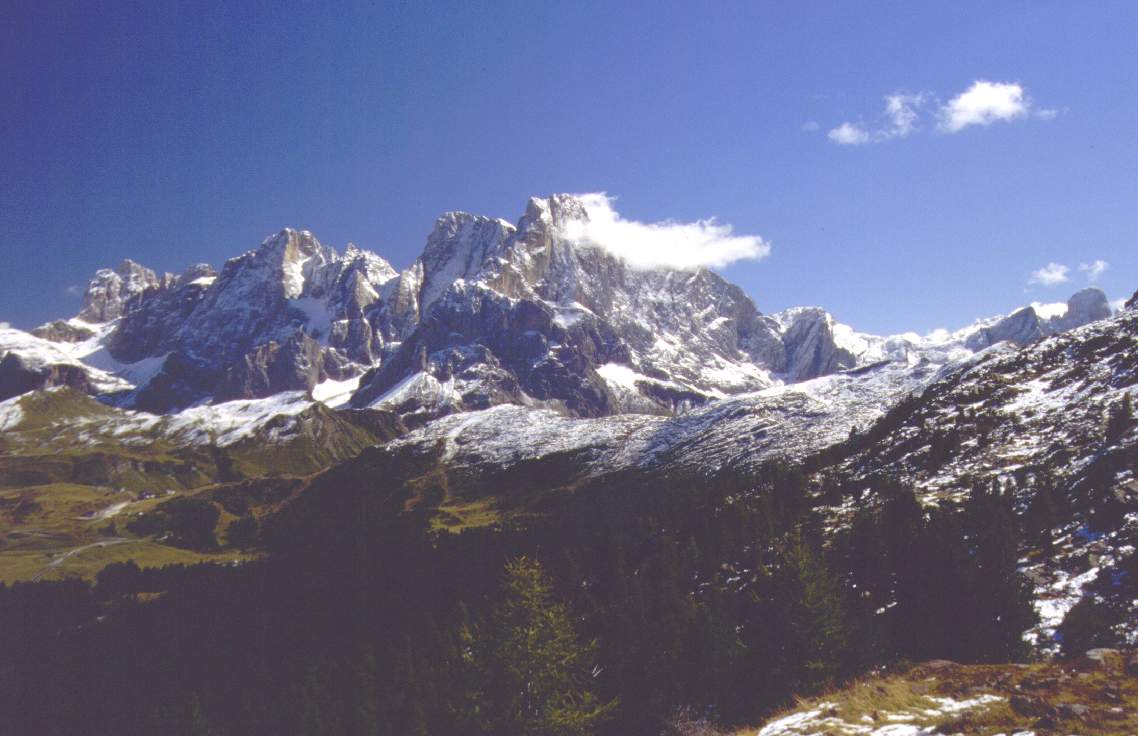
The forest of Paneveggio is located in the north-eastern part of the autonomous Province of Trento (Italy), between 1500 and 2100 m. The dominant species (>90% of the standing trees) is Norway spruce (Picea abies (L.) Karst.). In the upper part of the forest, Norway spruce is mixed with stone pine (Pinus cembra L.) and larch (Larix decidua Mill.). The forest is globally well known for the wood characteristics of 'spruce-trees of resonance', particularly suitable for the construction of music instruments. The forest is owned by the Province of Trento, and is part of the Paneveggio-Pale di S. Martino Park
This area has been used by man since the Mesolithic age and there are traces of summer settlements of hunters dating back to approximately 8000 bp . More recently the forest belonged to the Austro-Hungarian Empire. During the Austrian rule the first studies and the first plans for managing the forest, were made and are still available (Wessely, 1853; von Guttemberg 1915).
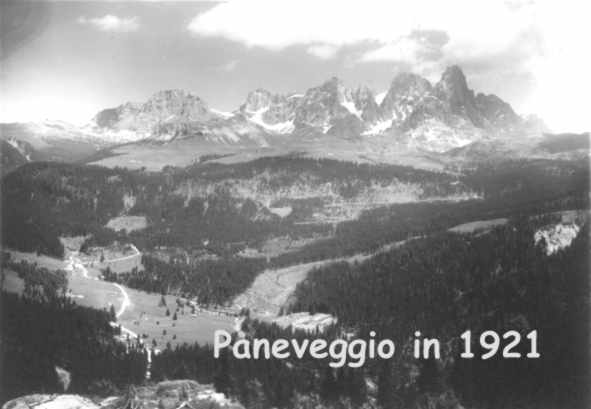 The forest was the stage for many fierce battles during the first world war as proved by the traces of trenches on the land and the discovery of shrapnels and bullets inside the trees. After the first world war the forest became Italian. After WWI , a total of 200000 m3 of wood was cut in the whole forest (an amount equivalent to that of 50 years of prescribed fellings) in salvage operation following war damages, windthrows and Ips typographus outbreaks.
With effect from the '60s the Paneveggio forest was the subject of many studies on ecology and on the regeneration of the subalpine Norway spruce stands with effect from 1992 (starting the 10th revision of the Management plan) a sector of the forest was taken a part and a Forest reserve was established.
Grazing by cattle was heavy until the early 70s. Nowadays the saplings and the seedlings are often damaged by wild ungulates. This forest is a habitat for the chamois (Rupicapra rupicapra L.) the whole year, for red (Cervus elaphus L.) and roe deer (Capreolus capreolus L.) during spring, summer and autumn and is used by red deer as a rutting area.
The forest was the stage for many fierce battles during the first world war as proved by the traces of trenches on the land and the discovery of shrapnels and bullets inside the trees. After the first world war the forest became Italian. After WWI , a total of 200000 m3 of wood was cut in the whole forest (an amount equivalent to that of 50 years of prescribed fellings) in salvage operation following war damages, windthrows and Ips typographus outbreaks.
With effect from the '60s the Paneveggio forest was the subject of many studies on ecology and on the regeneration of the subalpine Norway spruce stands with effect from 1992 (starting the 10th revision of the Management plan) a sector of the forest was taken a part and a Forest reserve was established.
Grazing by cattle was heavy until the early 70s. Nowadays the saplings and the seedlings are often damaged by wild ungulates. This forest is a habitat for the chamois (Rupicapra rupicapra L.) the whole year, for red (Cervus elaphus L.) and roe deer (Capreolus capreolus L.) during spring, summer and autumn and is used by red deer as a rutting area.
The forest of Paneveggio is significant for many reasons: its history and culture, its aesthetic character and environmental value, the quality of the wood, and as a good example of sustainable management. Owners and managers are fully aware of the fact that the forests are fundamental to both the landscape and tourism - the main activity in the Province - but the forests are still an important source of work and income for local communities. Sustainable management of the forests gives rise to jobs not only in the forests themselves, but along the whole wood forestry chain including the final production stages, promotion of the restoration of the watersheds, and the conservation of the landscape.
In Paneveggio, and more generally in Trento province, the management criteria are those of the 'control method': standing trees are measured periodically (10-15 years) and, taking into account harvesting and mortality, current increment and volume to be cut are established for each compartment of the forest. Timber marking is done according to the compartment increment data but giving particular consideration to the structure and natural regeneration of the forest. About 60% of the current increment is cut. Silviculture has a strong naturalistic character; living trees are usually conserved long past the age at which they are considered 'mature' from the economic point of view. Some stands, even in the most productive areas of the forest, are left to evolve naturally and silvicultural interventions are made every 30-40 years. Dead standing trees and woody coarse debris are maintained in order to increase the biodiversity and the natural value of the forest.
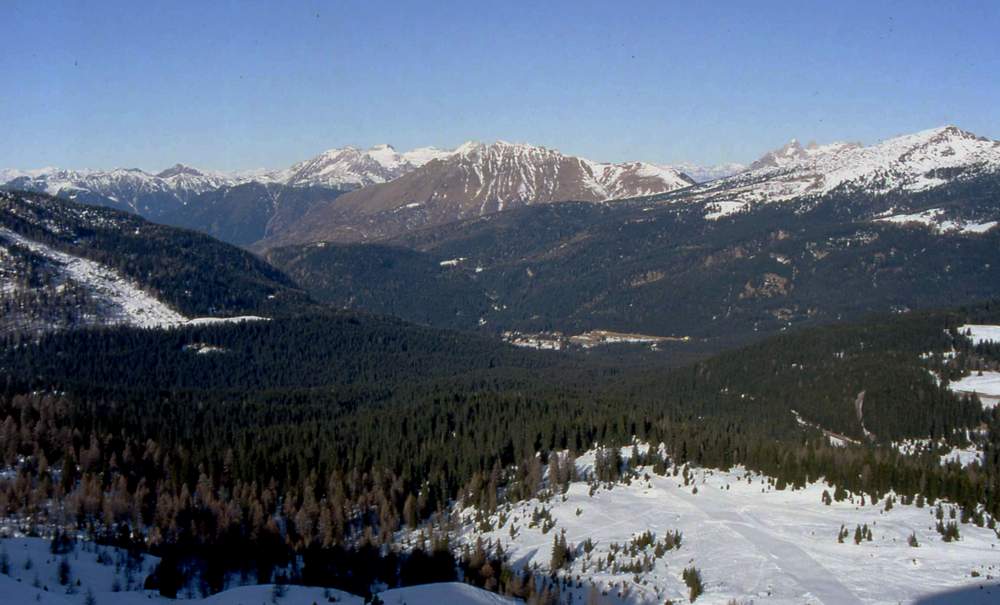
Previously, timber was the most important forest product. Current management aims are to maintain, or improve, the natural values, to maximize the public utilities (timber production, soil protection, landscape) produced by the forest, to promote environmental education, and to increase environmental knowledge. In the last few decades particularly, simultaneously with the reduction in anthropogenic activity, the need for a 'close-to-nature' silviculture has arisen, with the aim of developing forest stands that are comparable to virgin ones - with regard to structure, composition and regeneration properties. This silviculture can only be practised effectively by knowing the type, frequency and intensity of the natural disturbances (which are used as reference models for forest regeneration). However, very little is known about natural disturbance within European forests because of lack of research and the fact that, in cultivated forests, felling is used to avoid natural disturbance. Even in most currently unmanaged forests, previous anthropogenic disturbance hides, or has been confused with, natural disturbance.
Silvicultural research
In 1992, a forest reserve covering approximately 100 ha was established in 1992 (Dellagiacoma, Motta & Piussi, 1996). The study area is located in the Valbona (latitude 46�18', longitude 11�38') in the Travignolo Valley (Trentino, Italy).The predominant type of vegetation in this area is subalpine Norway spruce. The set aside area was divided into two parts. The reserve was divided into two parts; the first selected for silvicultural experiments (silvicultural reserve), and the second as a strict reserve (wilderness area) where silvicultural activity was excluded.
Several studies have been carried out in the silvicultural reserve, particularly concerned with developing or adapting the silvicultural approach, natural regeneration and ecological stability (e.g. Mencuccini, Piussi & Zanzi Sulli, 1995; Cherubini, Piussi & Schweingruber, 1996; Motta & Nola, 1996).
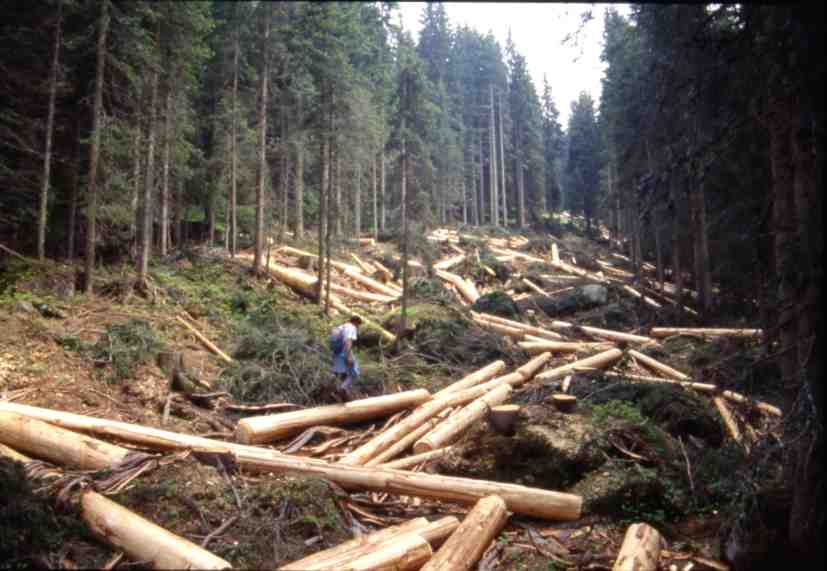 In 1993 seven little elongated clearcuts (total about 1 ha) were created;
In 1993 seven little elongated clearcuts (total about 1 ha) were created;
- 3 clearcuts (about 0.4 ha) have been afforested with larch and norway spruce and we are monitoring these afforestation to follow the growth in the two different species under different light and site conditions and different browsing protection;
- 4 clearcuts (about 0.6 ha) are used to observe the natural establishment processes of forest species and the concurrence of herbaceous species. Presently there are 32 transects of 40 m lenght where every 1 m there is a 20x20 cm area in the ground that is controlled twice a year for the seedling establishment and survival and the other species.
Other experiments in progress are:
- Inventories, dendroecological reasearches and monitoring about wild ungulate damages on forest regeneration;
- yearly seed production and viability (it has been performed since 1963);
- growth of the advance regeneration after the logging;
- colonization of dead trees by vegetation and by forest regeneration.
In the wilderness area four permanent plots (100 x 100 m) were established in 1994 to begin a long-term forest ecosystem research. Live and dead standing trees with a diameter > 7.5 cm at breast height (dbh at 1.3 m above the ground), along with stems, logs and stumps were identified, labelled with numbered metal tags and mapped. Two perpendicular diameters (dbh) were measured for each tree. Regeneration (h>10 cm, dbh<7.5 cm) was calculated in a transect (20 x 100 m), randomly selected inside the plot. Plot coordinates were determined by means of a Global Positioning System (G.P.S.) and all data were filed in a G.I.S. (Arcview 3.1).
Information about the disturbance history of a stand is crucial in studies of forest succession and the origin of structural patterns. Variations in tree-ring width can be used to reconstruct the occurrence of past forest disturbance and to speculate on the origin of the forest stand. In the forests of the European Alps, however, tree rings alone do not supply sufficient information, because most disturbances are of anthropogenic origin. It is therefore necessary to integrate tree-ring analysis with the documented history of the stand.
The first research step (Motta, Nola & Piussi, 1999; Motta, Nola & Piussi, 2000) in the plots was to describe the structures (e.g. vertical and horizontal patterns, age structure, spatial patterns) and to study their history using both dendroecological methods (e.g. abrupt growth releases) and written evidence from management plans and other historical records.
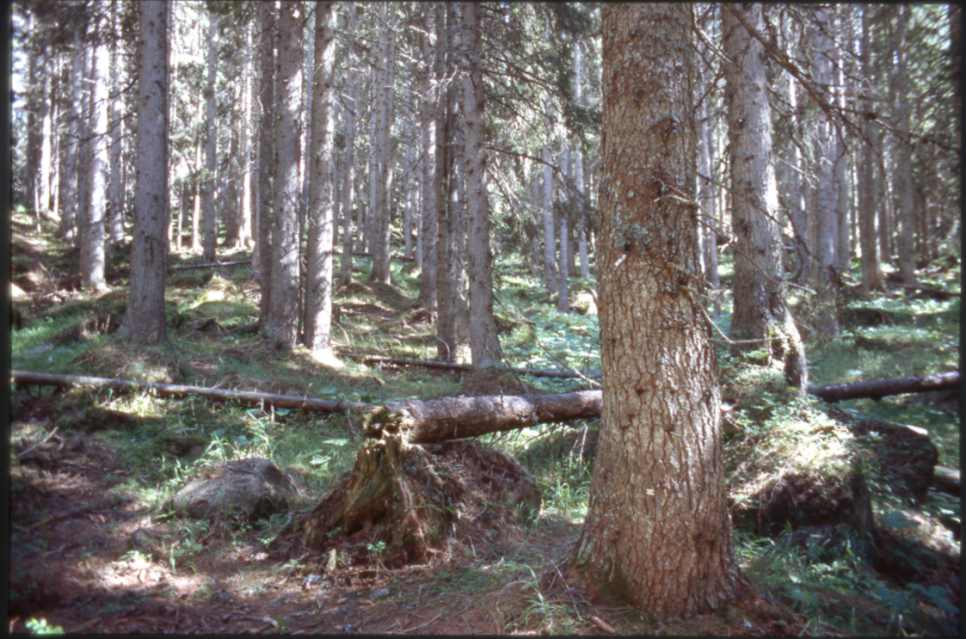 The Valbona 1 and 2 stands began to establish after a disturbance that removed part of the previous stands according to dendroecological studies, which are partially supported by the written evidence. The remaining parts of these stands were eliminated by two major disturbances that occurred during the following decades. Written records about the use of the forest lead us to assume that the initial disturbances that occurred in the two stands were logging activities as a part of a group shelterwood system. The stand in plot 2 has developed without significant human interference for about half a century as confirmed by the presence of many dead trees.
The Valbona 1 and 2 stands began to establish after a disturbance that removed part of the previous stands according to dendroecological studies, which are partially supported by the written evidence. The remaining parts of these stands were eliminated by two major disturbances that occurred during the following decades. Written records about the use of the forest lead us to assume that the initial disturbances that occurred in the two stands were logging activities as a part of a group shelterwood system. The stand in plot 2 has developed without significant human interference for about half a century as confirmed by the presence of many dead trees.
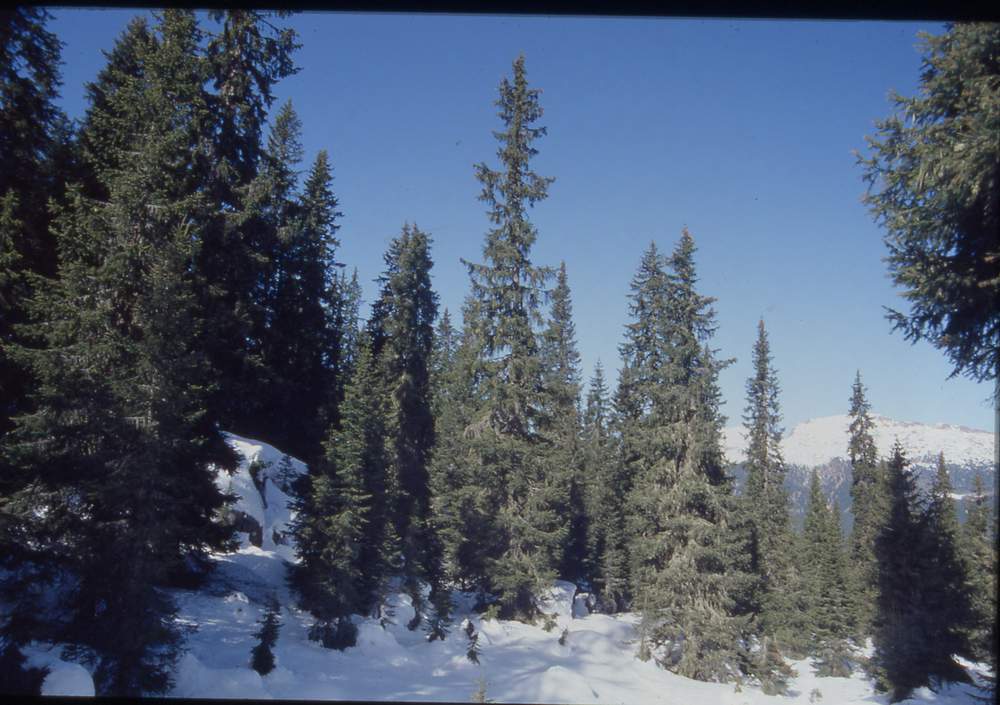 In the Valbona 3 stand age structure analysis revealed an uneven-age population in which the oldest trees were more than 400 years old. The regeneration establishment during the last three centuries was quite continuous, in time and in space; the principle decades showing a high incidence of disturbance were the decades 1740-50, 1770-80, 1780-90, 1820-1830 but the stand has been affected quite regularly by disturbances all over the last three centuries; this fact, coupled together with the age structure and the information gleaned from historical documents, supports the hypothesis that in this area a plenterwald system was carried out over the last centuries. The application of this plenterwald was probably different from the present meaning (single tree or small-group selection system) but allowed to maintain a continuous forest cover.
In the Valbona 3 stand age structure analysis revealed an uneven-age population in which the oldest trees were more than 400 years old. The regeneration establishment during the last three centuries was quite continuous, in time and in space; the principle decades showing a high incidence of disturbance were the decades 1740-50, 1770-80, 1780-90, 1820-1830 but the stand has been affected quite regularly by disturbances all over the last three centuries; this fact, coupled together with the age structure and the information gleaned from historical documents, supports the hypothesis that in this area a plenterwald system was carried out over the last centuries. The application of this plenterwald was probably different from the present meaning (single tree or small-group selection system) but allowed to maintain a continuous forest cover.
The Buse dell'oro stand when analyzed for age structure also showed an uneven-aged population with oldest trees more than 400 years old. This plot has been affected quite regularly by disturbances too but the principle decades with a high incidence of disturbance were identified as 1690-1700, 1720-1730, 1820-1830, 1920-1930. However, differently from that which took place in the Valbona 3 stand, massive regeneration in this area occurred only following the disturbance recorded in 1920. Prior to this date, few trees were present, and these were limited almost exclusively to Norway spruce and larch. After 1920 numerous trees establishment occurred and stone pine trees also established successfully. It is therefore plausible to theorize that the area was utilized as pasture up to the end of the 19th century. This pasture was subsequently abandoned before and during the first world war (indeed, trenches are still visible a few meters' distance from the area) and more than 90% of the present trees were settled in the decades following the end of the war.
The last two plots, though sharing a relatively similar present structure, actually developed in entirely different ways. This study has confirmed that biological data-bases can be used to identify localization occurrence and the intensity of previous disturbance in forest stands, though the causes of the disturbance in cultivated forests can be determined only by means of the study of and comparison between biological data-bases and historical records.
The main purpose of the forest reserve is to make key long-term biological processes an integral part of forest management, and to outline the practical measures necessary to promote multi-purpose forest use that simultaneously embraces environmental, protection and production values.
Silviculture can be seen as the tool of reconciliation between the ecological needs of the forest and the social and economic needs of humans. It must take both global and local expectations into account, as well as the growing volume of scientific knowledge acquired through forest research. The best results - i.e. the point where human requirements are best satisfied within a framework of equilibrium between commercial and social requirements and the ecological requirements of the forest - can only be achieved through active and correct management which takes account of past experience while exploiting new knowledge.
Some papers
Cherubini, P., Piussi, P., Schweingruber, F. H. 1996. Spatiotemporal growth dynamics and disturbances in a subalpine spruce forest in the Alps: a dendroecological reconstruction. Canadian Journal of Forest Resesarch, 26: 991-1001.
Dellagiacoma, F., Motta, R., Piussi, P. 1996. Ricerche sull'ecologia della pecceta subalpina nella foresta di Paneveggio (TN). Dendronatura, 17: 77-86.
Mencuccini, M., Piussi, P., Zanzi Sulli, A. (1995) Thirty years of seed production in a subalpine Norway spruce forest: patterns of temporal and spatial variation. Forest Ecology and Management 76, 109-125.
Motta, R., Nola, P. (1996) Fraying damages in the subalpine forest of Paneveggio (Trento, Italy): a dendroecological approach. Forest Ecology and Management 88, 81-86.
Motta, R., Nola, P., Piussi, P., 1999. Structure and stand development in three subalpine Norway spruce (Picea abies (L.) Karst.) stands in Paneveggio (Trento, Italy). Global Ecology and Biodiversity, 8, 455-473.
Motta, R., Nola, P., Piussi, P., 2000. Structure and stand development in a mixed Norway spruce (Picea abies (L.) Karst.), larch (Larix decidua Mill.) and stone pine (Pinus cembra L.) stand in Paneveggio (Trento, Italy). Dendrochronologia, 16-17, 57-74.
Motta, R., Nola, P., Piussi, P., 2002. Long-term investigations in a strict forest reserve in the Eastern Italian Alps: spatio-temporal origin and development in two multi-layered sub-alpine stands. Journal of Ecology, in press.
Motta, R., 2002. Old-growth forests and silviculture in the Italian Alps: the case-study of the strict reserve of Paneveggio (TN). Plant Biosystems, in press.
Piussi, P. (1965) Alcune osservazioni ed esperienze sulla rinnovazione naturale di Picea nella foresta di Paneveggio (Trento). Annali Accademia Italiana di Scienze Forestali 14, 345-400.
Piussi, P. (1976) Observations sur l'�ge et la croissance en diam�tre de certains �pic�as de haute montagne. Beiheft zu den Zeit. des Schw. Fortsvereins 57, 66-73.
Piussi, P. (1979) Nuovi studi sulla rinnovazione delle peccete nella Valle di Fiemme. Memorie Museo Tridentino Scienze Naturali 23, 113-169.
Piussi, P. (1988) Accrescimento e sopravvivenza del novellame di Picea in tagliate a raso a buca. Scritti di Selvicoltura in onore del Prof. Alessandro de Philippis, Firenze, 209-221.
A short walk throught the forest
